Sgt. Alvin C. York
rose from poverty in rural Tennessee to become
one of America's great heroes on World War I,
despite first seeking a religious exemption from
the draft.
Sergeant Alvin York was a reluctant Christian
soldier.?
Yet the battlefield heroics of the born-again
backwoodsman and??astounded even the most
hardened soldiers of World War I.?
"What
you did was the greatest thing accomplished by any
private soldier of all the armies of Europe," he was
reportedly told by??Marshal Ferdinand Foch,
the commander of Allied forces in the Great War.?
York's
actions, for which he earned the Medal of Honor, still
astound Americans today.
Leading
seven men behind enemy lines — the remnants of a U.S.
Army platoon slaughtered in the Meuse-Argonne Offensive
on Oct. 8, 1918 — York killed an estimated 20 Germans,
took 132 prisoners and silenced as many 25 machine
guns.?
He
brazenly marched his captors past enemy trenches back to
American lines.
Full-length
portrait of Sergeant Alvin C. York (1887-1964), of
the 328th Infantry Regiment, who with the aid of 17
men captured 132 German prisoners and became one of
the most decorated American soldiers of World War I,
near Cornay, France, February 1919. The location of
the photo shows the hill upon which the raid took
place.??(Photo by Interim
Archives/Getty Images)
Sergeant
York earned the acclaim of the nation.?
Yet he
suffered a personal battle much of his life, fearing
condemnation??for taking the lives
of other human beings.?
Young
Alvin York "lived a life of drinking and gambling and
smoking," his grandson, retired U.S. Army Colonel Gerald
York, told Fox News Digital.?
"His
fortunes changed when he gave his life to Christ" around
1915.
"I
wanted to be a good Christian and a good American
too." — Sergeant Alvin York
York
first refused to fight when the United States entered
World War I in 1917. He filed as a conscientious
objector, but ultimately submitted to Uncle Sam.
His??inspired the World War
II generation.?
The
movie version of his life, "Sergeant York," starring
Gary Cooper, hit the silver screen in 1941. ?
It
earned 11??and two Oscar wins,
including Best Actor for Cooper, and was the
top-grossing movie of the year.?
"Sergeant
York" was being shown in theaters on Dec. 7 when Japan
attacked Pearl Harbor,?.?
Marshall
Ferdinand Foch of France at his desk. The commander
of all Allied forces in World War I said U.S. Army
Sgt. Alvin York's heroic capture of 132 Germans "was
the greatest thing accomplished by any private
soldier of all the armies of Europe."?(Getty Images)
"There
were numerous reports of young men leaving movie
theaters and going to enlist, so fervent was their
patriotism," reported the Knoxville Focus.
York
may have doubted his deadly actions — but never his
patriotism. Among his eight children: Woodrow Wilson,
Sam Houston, Andrew Jackson, Betsy Ross and Thomas
Jefferson York.?
"He was
just daddy to me," daughter Betsy Ross York, now 89 and
a resident of Bowling Green, Kentucky, told Fox News
Digital.?
"He
never did talk about the war, and we didn’t ever ask
him."
Born in backwood poverty
Alvin
Cullum York was born in Pall Mall, Tennessee, on Dec.
13, 1887, to William and Mary (Brooks) York.?
"The
Yorks struggled in poverty, which only worsened when
York’s father died in 1911," writes the National Museum
of the Army.
Sergeant York,
poster, Gary Cooper on a "Style A" half-sheet
poster, 1941.??(Photo by LMPC via
Getty Images)
"York
only had nine months of schooling but had gained a
variety of skills exploring and hunting for game in the
mountains of Tennessee. York became a skilled marksman
and continued to work jobs around Pall Mall to support
his family."
He
became a member as an elder at the??following
his awakening, adopting pacifism.?
"He
told producers that he felt like he was struck by
lightning when he found Christ."
The
movie shows York’s conversion come as he was nearly
struck by lightning. But that was Hollywood's
dramatization of the event.
"He
told producers that he felt like he was struck by
lightning when he found Christ," grandson Gerald York
said.?
The
future Sergeant York was of fighting age — 29 — when the
U.S. entered World War I.?
Preview of film
"Sergeant York" at Knickerbocker Theatre, Nashville,
Tennessee, July 1941. Front row, left to right: Joe
Oehmig, Gov. Prentice Cooper, Mrs. Gracie York,
Sergeant Alvin York, Mayor Thomas L. Cummings.??(Courtesy
Sergeant York Patriotic Foundation)
"My
religion and my experience ... told me not to go to war,
and the memory of my ancestors ... told me to get my gun
and go fight," York wrote of his inner conflict.?
"I
wanted to be a good Christian and a good American, too.
I was not a Sunday Christian. I believed in the Bible,
and I tried in my own way to live up to it."
Uncle
Sam gave him little choice.?
Alvin
C. York, who had rarely if ever left his little corner
of heaven in rural Tennessee, shipped off across the
ocean for hell.
Mowed down like blades of grass
York
entered the war in France as a member of the 82nd
Division — which become??of
paratroopers. They rose to fame jumping into Normandy in
World War II.?
He
awoke on the morning of Oct. 8, 1918, to find himself in
the midst of a savage battle, which he recorded in a
diary published in 1922.
Portrait of U.S.
Army Sergeant Alvin York (1887-1964) seated in his
military uniform, between 1915 and 1920.??(Photo by
Library of Congress/Interim Archives/Getty Images)
His
unit was struck by artillery and gas attacks and then
marched on a German position heavily fortified with
machine guns.?
"Our
boys just went down like the long grass before the
mowing machine at home," the hillbilly soldier wrote
metaphorically of watching his comrades slaughtered.?
"Our
boys just went down like the long grass before the
mowing machine at home." — Sergeant York
"I just
knew that we couldn't go on again until those machine
guns were mopped up. So we decided to try and get them
by a surprise attack in the rear. We figured there must
have been over 30," he also wrote — meaning 30 machine
guns. ?
York
was in charge of the few remaining men after all their
officers were killed.?
Frighteningly
outnumbered and behind enemy lines, York found a firing
position and began picking off German soldiers one by
one.?
Photograph of the
326th Infantry, 82nd Division, advancing on enemy
positions in Choloy, France. Dated 1918.??(Photo by:
Universal History Archive/Universal Images Group
via Getty Images)
"Every
time a head come up, I done knocked it down … I was
giving them the best I had."
He
likened it to the way he shot turkeys back home.?
"In the
middle of the fight a German officer and five men done
jumped out of a trench and charged me with fixed
bayonets … I only had about half a clip left in my
rifle; but I had my pistol ready. I done flipped it out
fast and teched them off, too."
The
Germans were stunned after seeing six men dropped so
quickly. They began surrendering en masse, fearing they
faced a larger American unit.
American actor
Gary Cooper (center) on the set of the film
"Sergeant York," directed by Howard Hawks.??(Photo by
Sunset Boulevard/Corbis via Getty Images)
A
German major, who spoke fluent English, facilitated the
surrender and the march back to American lines.
"There
was so many [Germans] there was danger of our own
artillery mistaking us for a German counter-attack and
opening up on us," York wrote.
"Lieutenant
Woods came out and counted 132 prisoners. And when he
counted them he said, ‘York, have you captured the whole
German army?’ And I told him I had a tolerable few."
York’s
exploits became legend on the battlefront. But he never
shared his story in his many letters back home.?
Close-up of
American soldiers of the 18th Infantry, 1st Division
holed up on the side of Hill 240 in the Ardennes,
during the Meuse-Argonne Offensive, France, Oct. 11,
1918.??(Photo by
PhotoQuest/Getty Images)
His
family only learned of his heroics when the exploits
were written up in the April 26, 1919, edition of the
Saturday Evening Post, then one of the most widely read
publications in America.
"He
outfought the machine-gun battalion with his rifle and
automatic pistol," enthused Canadian war correspondent
George Pattullo.?
"It
stands out as the greatest individual feat of the war,
not only because of the amazing things he did that day,
but because of the man’s deep religious convictions and
scruples."
‘Sense of peace before he
died’
Sergeant
Alvin C. York died on Sept. 2, 1964, in Nashville after
a long illness that left him incapacitated in his later
years.?
World War I hero
Alvin C. York. "He outfought the machine-gun
battalion with his rifle and automatic pistol,"
enthused Canadian war correspondent George Pattullo
in the Saturday Evening Post.??(Getty Images)
President
Lyndon B. Johnson led a long list of dignitaries who
attended his funeral.?
York is
buried in his hometown of Pall Mall.?
His
legacy lives on an incredible number of ways, both big
and small.?
The
82nd Airborne gifted one of its most famous veterans in
his later years a 1957 Pontiac. The York family still
keeps and cherishes the automobile today.
Sergeant
York used his royalties from the movie to support his
church and fund a short-lived Bible school.?
The 82nd Airborne
Division gifted Sgt. Alvin York with a 1957 Pontiac
in his later years. The family still keeps it as a
possession. Shown here with the vehicle are two of
his children, late son Andrew Jackson York and
daughter Betsy Ross York.??(Courtesy York
Family)
He also
founded the Alvin C. York Institute in 1926. It was
transferred to state management in 1937 and still
teaches high school students today,?
"It is
the only comprehensive secondary school in the United
States that is financed and operated by a state
government," according to the school website.
The
Sgt. Alvin C. York State Historic Park is a Tennessee
attraction that includes the York Farm, a National
Historic Landmark.?
His
descendants run the Sergeant York Patriotic Foundation.
Pall Mall hosts a Veterans Day celebration on his
property each November 11. His family will attend.
York
Avenue on Manhattan’s Upper East Side appears to be just
another New York City landmark attributed to its
namesake community in England.?However, it was named for
Sergeant York in 1928.
A book, a movie,
a sketch and post stamps featuring Alvin York, a
U.S. sergeant in World War I, are on display on a
table in Alexandria, Virginia, on Oct. 2, 2018.
Sergeant York received the Medal of Honor for
leading an attack on a German machine gun nest
during the United States-led portion of the
Meuse-Argonne Offensive in France, taking 35 machine
guns, killing at least 25 enemy soldiers and
capturing 132 men. ??(EVA
HAMBACH/AFP via Getty Images)
York’s
second child, George Edward Buxton, was named for the
sergeant's commanding officer in the army.?
George
answered the call of Christ and became a minister.
Sergeant York asked his son for forgiveness for his sins
in battle as death approached, according to Col. Gerald
York.?
"My dad
told him, 'You did what you did out of service to your
country and your fellow soldiers. You didn't do it out
of malice or hate. You did it to save lives, to stop the
carnage of your own men.'"
Added
Colonel York, "I think it helped. I think it gave my
grandfather a sense of peace before he died."
To
read more stories in this unique "Meet the American
Who…" series from Fox News Digital,?.?
Kerry J. Byrne
is a lifestyle reporter with Fox News Digital.



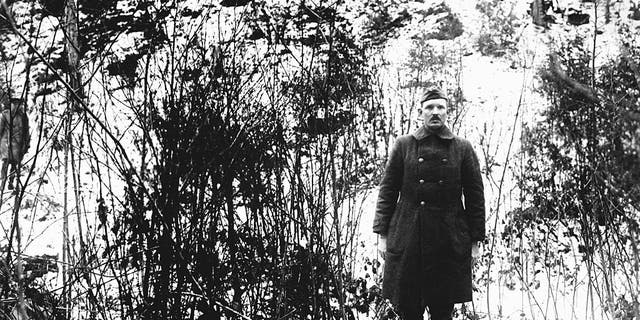


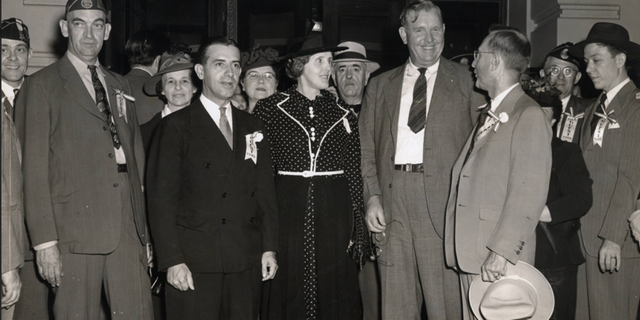
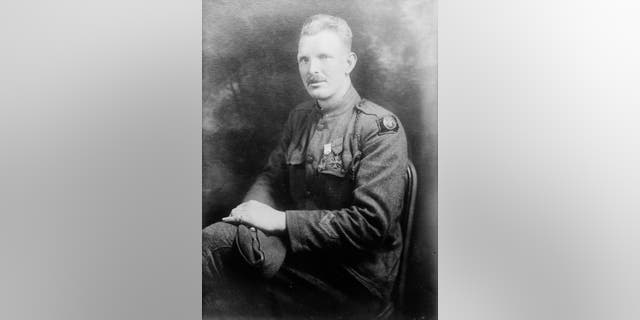
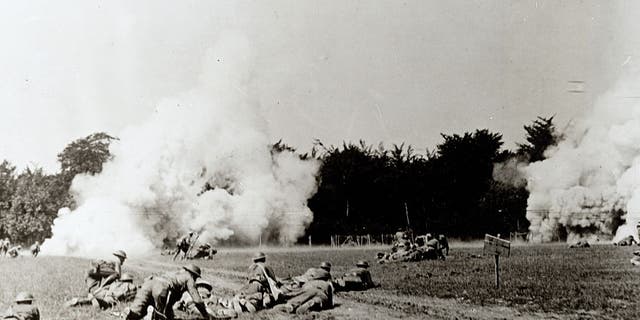
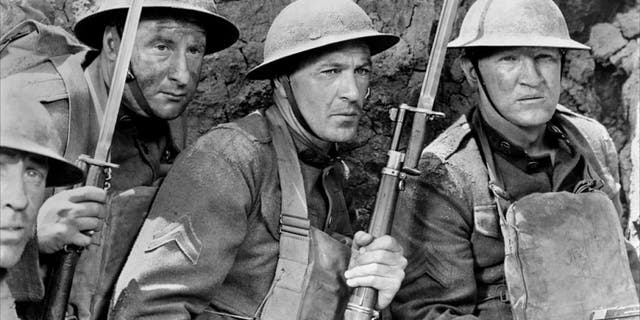



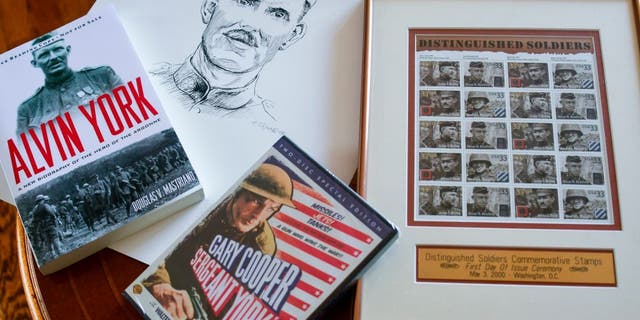























 ?
? 








